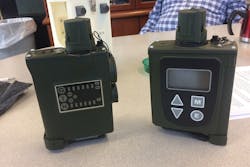Homeland Security approaches industry for new surveillance sensors to detect biological warfare agents
WASHINGTON – U.S. Department of Homeland Security (DHS) researchers are asking industry to weigh-in on anticipated requirements to modernize and enhance portable systems to monitor continuously for existing and emerging biological warfare agents.
Officials of the DHS Countering Weapons of Mass Destruction Office in Washington released a request for information (70RWMD23RFI00000008) on Thursday for the Rapid Assay Biosensor Redesign project.
DHS researchers are looking for companies able to replace or upgrade immunoassay-based bio identification sensors with technologies for rapid and reliable detection and identification of biological agents, bacteria, viruses, toxins, proteins, and nucleic acids.
Immunoassay systems monitor and measure for the presence of biochemical agents that consist of concentrations of macromolecule or small molecules in solutions through the use of an antibody or an antigen.
The goal is the ability for continuous surveillance that would identify biological agents within minutes of detection, with automated sample preparation, analysis, and identification of agents with less than a 0.05 percent false alarm rate.
Researchers want to detect and identify specific biological agents with near polymerase chain reaction level sensitivity, with rapidly deployable immunoassay-based bio detectors for real-time continuous and phased collection monitoring for existing and emerging biological threats. Bio identifiers autonomously should be able to monitor, sample, analyze, and identify with near immunoassay-level sensitivity.
This project should last for as long as five years, with technology design, validation, and development of as many as 10 prototypes within the first two years with additional prototype development in subsequent years.
These portable detectors for biological warfare agents should be able to identify at least 5 top-tier targeted threats; detect bacteria, viruses, toxins, proteins, and nucleic acids; have less than 0.05 percent false alarm rates; identify biological threats in less than five minutes; capture particles as large as 10 microns; be portable and weigh no more than 60 pounds; and operate on 120-volt 60 Hz power of less than 15 amps.
Technologies should be able to perform more than four sample collections and tests without physical maintenance; be smaller than four square feet; have Ethernet ports for communications; and have expandable libraries and the ability to add new threat agent assays.
The false alarm rate should be near zero, and the system must be able to self-check to reject spurious or false alarms. The system should be able to operate continuously for one week to one month between maintenance checks indoors and outdoors.
The system should be able rapidly to prototype assays to identify additional known and emerging unknown biothreats; and offer network, Bluetooth, and wireless connectivity for data transfer.
Companies interested email responses no later than 24 March 2023 to the DHS's Clement Ezeanii at [email protected] and Andrew Whittaker at [email protected]. The subject line of the email should contain the RFI number 70RWMD23RFI00000008.
Responses should include rough-order-of-magnitude cost estimates; estimated technical approaches to develop, prototype, integrate, and validate six to ten bio identifiers; and past operational and government independent performance assessments.
Email questions or concerns to Clement Ezeanii at [email protected] and Andrew Whittaker at [email protected]. More information is online at https://sam.gov/opp/7c34805e07d64275a6c9508ba0cc3042/view.
About the Author
John Keller
Editor-in-Chief
John Keller is the Editor-in-Chief, Military & Aerospace Electronics Magazine--provides extensive coverage and analysis of enabling electronics and optoelectronic technologies in military, space and commercial aviation applications. John has been a member of the Military & Aerospace Electronics staff since 1989 and chief editor since 1995.
